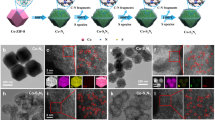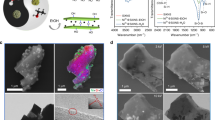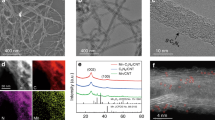Abstract
Hydrogenation of CO2 into fuels and useful chemicals could help to reduce reliance on fossil fuels. Although great progress has been made over the past decades to improve the activity of catalysts for CO2 hydrogenation, more efficient catalysts, especially those based on non-noble metals, are desired. Here we incorporate N atoms into Co nanosheets to boost the catalytic activity toward CO2 hydrogenation. For the hydrogenation of CO2, Co4N nanosheets exhibited a turnover frequency of 25.6 h−1 in a slurry reactor under 32 bar pressure at 150 °C, which was 64 times that of Co nanosheets. The activation energy for Co4N nanosheets was 43.3 kJ mol−1, less than half of that for Co nanosheets. Mechanistic studies revealed that Co4N nanosheets were reconstructed into Co4NH x , wherein the amido-hydrogen atoms directly interacted with the CO2 to form HCOO* intermediates. In addition, the adsorbed H2O* activated amido-hydrogen atoms via the interaction of hydrogen bonds.
This is a preview of subscription content, access via your institution
Access options
Access Nature and 54 other Nature Portfolio journals
Get Nature+, our best-value online-access subscription
$29.99 / 30 days
cancel any time
Subscribe to this journal
Receive 12 digital issues and online access to articles
$119.00 per year
only $9.92 per issue
Buy this article
- Purchase on Springer Link
- Instant access to full article PDF
Prices may be subject to local taxes which are calculated during checkout




Similar content being viewed by others
References
Behrens, M. et al. The active site of methanol synthesis over Cu/ZnO/Al2O3 industrial catalysts. Science 336, 893–897 (2012).
Chinchen, G. C., Denny, P. J., Parker, D. G., Spencer, M. S. & Whan, D. A. Mechanism of methanol synthesis from CO2/CO/H2 mixtures over copper/zinc oxide/alumina catalysts: use of 14C-labelled reactants. Appl. Catal. 30, 333–338 (1987).
Spencer, M. S. The role of zinc oxide in Cu/ZnO catalysts for methanol synthesis and the water-gas shift reaction. Top. Catal. 8, 259–266 (1999).
Kuld, S. et al. Quantifying the promotion of Cu catalysts by ZnO for methanol synthesis. Science 352, 969–974 (2016).
Preti, D., Resta, C., Squarcialupi, S. & Fachinetti, G. Carbon dioxide hydrogenation to formic acid by using a heterogeneous gold catalyst. Angew. Chem. Int. Ed. 50, 12551–12554 (2011).
Moret, S., Dyson, P. J. & Laurenczy, G. Direct synthesis of formic acid from carbon dioxide by hydrogenation in acidic media. Nat. Commun. 5, 4017 (2014).
Schneidewind, J., Adam, R., Baumann, W., Jackstell, R. & Beller, M. Low-temperature hydrogenation of carbon dioxide to methanol with a homogeneous cobalt catalyst. Angew. Chem. Int. Ed. 56, 1890–1893 (2017).
Rezayee, N. M., Huff, C. A. & Sanford, M. S. Tandem amine and ruthenium-catalyzed hydrogenation of CO2 to methanol. J. Am. Chem. Soc. 137, 1028–1031 (2015).
Khan, M. U. et al. Pt3Co octapods as superior catalysts of CO2 hydrogenation. Angew. Chem. Int. Ed. 55, 9548–9552 (2016).
Zhang, W. et al. Integration of quantum confinement and alloy effect to modulate electronic properties of RhW nanocrystals for improved catalytic performance toward CO2 hydrogenation. Nano. Lett. 17, 788–793 (2017).
Yang, X. et al. Low pressure CO2 hydrogenation to methanol over gold nanoparticles activated on a CeOx/TiO2 interface. J. Am. Chem. Soc. 137, 10104–10107 (2015).
Liao, F. et al. Electronic modulation of a copper/zinc oxide catalyst by a heterojunction for selective hydrogenation of carbon dioxide to methanol. Angew. Chem. Int. Ed. 51, 5832–5836 (2012).
Matsubu, J. C., Yang, V. N. & Christopher, P. Isolated metal active site concentration and stability control catalytic CO2 reduction selectivity. J. Am. Chem. Soc. 137, 3076–3084 (2015).
Iablokov, V. et al. Size-controlled model co nanoparticle catalysts for CO2 hydrogenation: synthesis, characterization, and catalytic reactions. Nano Lett. 12, 3091–3096 (2012).
Calaza, F. et al. Carbon dioxide activation and reaction induced by electron transfer at an oxide-metal interface. Angew. Chem. Int. Ed. 54, 12484–12487 (2015).
He, Z. et al. Water-enhanced synthesis of higher alcohols from CO2 hydrogenation over a Pt/Co3O4 catalyst under milder conditions. Angew. Chem. Int. Ed. 55, 737–741 (2016).
Liu, C. et al. Carbon dioxide conversion to methanol over size-selected Cu4 clusters at low pressures. J. Am. Chem. Soc. 137, 8676–8679 (2015).
Wang, F. et al. Active site dependent reaction mechanism over Ru/CeO2 catalyst toward CO2 methanation. J. Am. Chem. Soc. 138, 6298–6305 (2016).
Matsubu, J. C. et al. Adsorbate-mediated strong metal-support interactions in oxide-supported Rh catalysts. Nat. Chem. 9, 120–127 (2017).
Li, C. S. et al. High-performance hybrid oxide catalyst of manganese and cobalt for low-pressure methanol synthesis. Nat. Commun. 6, 6538 (2015).
Graciani, J. et al. Highly active copper-ceria and copper-ceria-titania catalysts for methanol synthesis from CO2. Science 345, 546–550 (2014).
Li, Y., Chan, S. H. & Sun, Q. Heterogeneous catalytic conversion of CO2: a comprehensive theoretical review. Nanoscale 7, 8663–8683 (2015).
Studt, F. et al. Discovery of a Ni-Ga Catalyst for carbon dioxide reduction to methanol. Nat. Chem. 6, 320–324 (2014).
Nam, K. M. et al. Single-crystalline hollow face-centered-cubic cobalt nanoparticles from solid face-centered-cubic cobalt oxide nanoparticles. Angew. Chem. Int. Ed. 47, 9504–9508 (2008).
Oda, K., Yoshio, T. & Oda, K. Preparation of Co-N films by RF-sputtering. J. Mater. Sci. 22, 2729–2733 (1987).
Pozzo, M. & Alfe, D. Hydrogen dissociation and diffusion on transition metal (=Ti, Zr, V, Fe, Ru, Co, Rh, Ni, Pd, Cu, Ag)-doped Mg(0001) surfaces. Int. J. Hydrogen Energy 34, 1922–1930 (2009).
Gomez, T., Florez, E., Rodriguez, J. A. & Illas, F. Reactivity of transition metals (Pd, Pt, Cu, Ag, Au) toward molecular hydrogen dissociation: extended surfaces versus particles supported on TiC(001) or small is not always better and large is not always bad. J. Phys. Chem. C 115, 11666–11672 (2011).
Rodriguez, J. A. et al. Hydrogenation of CO2 to methanol: importance of metal-oxide and metal-carbide interfaces in the activation of CO2.ACS Catal. 5, 6696–6706 (2015).
Bai, S. et al. Highly active and selective hydrogenation of CO2 to ethanol by ordered Pd-Cu nanoparticles. J. Am. Chem. Soc. 139, 6827–6830 (2017).
Rasko, J., Kecskes, T. & Kiss, J. Adsorption and reaction of formaldehyde on TiO2-supported Rh catalysts studied by FTIR and mass spectrometry. J. Catal. 226, 183–191 (2004).
Sun, S. et al. Photocatalytic oxidation of gaseous formaldehyde on TiO2: an in-situ DRIFTS study. Catal. Lett. 137, 239–246 (2010).
Huang, Q. W., Zeng, D. W., Li, H. Y. & Xie, C. S. room temperature formaldehyde sensors with enhanced performance, fast response and recovery based on zinc oxide quantum dots/graphene nanocomposites. Nanoscale 4, 5651–5658 (2012).
Toth, M. et al. Hydrogenation of carbon dioxide on Rh, Au and Au-Rh bimetallic clusters supported on titanate nanotubes, nanowires and TiO2. Top. Catal. 55, 747–756 (2012).
Yang, R. Q., Fu, Y. L., Zhang, Y. & Tsubaki, N. In situ DRIFT study of low-temperature methanol synthesis mechanism on Cu/ZnO catalysts from co2-containing syngas using ethanol promoter. J. Catal. 228, 23–35 (2004).
Korhonen, S. T., Banares, M. A., Fierro, J. L. G. & Krause, A. O. I. Adsorption of methanol as a probe for surface characteristics of zirconia-, alumina-, and zirconia/alumina-supported chromia catalysts. Catal. Today 126, 235–247 (2007).
Kahler, K., Holz, M. C., Rohe, M., Strunk, J. & Muhler, M. Probing the reactivity of ZnO and Au/ZnO nanoparticles by methanol adsorption: a TPD and DRIFTS study. ChemPhysChem 11, 2521–2529 (2010).
Jacobs, G. & Davis, B. H. In situ DRIFTS investigation of the steam reforming of methanol over Pt/ceria. Appl. Catal. A-Gen. 285, 43–49 (2005).
Lin, S. D., Cheng, H. K. & Hsiao, T. C. In situ DRIFTS study on the methanol oxidation by lattice oxygen over Cu/ZnO catalyst. J. Mol. Catal. A-Chem. 342, 35–40 (2011).
Flores-Escamilla, G. A. & Fierro-Gonzalez, J. C. Participation of linear methoxy species bonded to Ti4+ sites in the methanol carbonylation catalyzed by TiO2-supported rhodium: an infrared investigation. J. Mol. Catal. A-Chem. 359, 49–56 (2012).
Acknowledgements
This work was supported by the Collaborative Innovation Center of Suzhou Nano Science and Technology, MOST of China (2014CB932700), NSFC (21573206 and 51371164), Key Research Program of Frontier Sciences of the CAS (QYZDB-SSW-SLH017), Anhui Provincial Key Scientific and Technological Project (1704a0902013), and Fundamental Research Funds for the Central Universities.
Author information
Authors and Affiliations
Contributions
L.W., W.Z. and X. Zheng equally contributed to this work. L.W. and J.Z. designed the studies and wrote the paper. L.W., W.Z., and Y.C. synthesized catalysts. L.W., W.Z., W.W. and J.Q. performed catalytic tests. L.W., Xiangchen Zhao, Xiao Zhao and Y.D. conducted in situ DRIFT, XRD, solid-state D-NMR and isotope measurements. L.W. and Xus.Z. conducted quasi in situ XPS measurements. All authors discussed the results and commented on the manuscript.
Corresponding author
Ethics declarations
Competing interests
The authors declare no competing financial interests.
Additional information
Publisher’s note: Springer Nature remains neutral with regard to jurisdictional claims in published maps and institutional affiliations.
Electronic supplementary material
Supplementary Information
Supplementary Figures 1–28, Supplementary Tables 1 and 2
Rights and permissions
About this article
Cite this article
Wang, L., Zhang, W., Zheng, X. et al. Incorporating nitrogen atoms into cobalt nanosheets as a strategy to boost catalytic activity toward CO2 hydrogenation. Nat Energy 2, 869–876 (2017). https://doi.org/10.1038/s41560-017-0015-x
Received:
Accepted:
Published:
Issue Date:
DOI: https://doi.org/10.1038/s41560-017-0015-x
This article is cited by
-
Spectroscopic visualization of reversible hydrogen spillover between palladium and metal–organic frameworks toward catalytic semihydrogenation
Nature Communications (2024)
-
Small-sized Ni-Co/Mo2C/Co6Mo6C2@C for efficient alkaline and acidic hydrogen evolution reaction by an anchoring calcination strategy
Frontiers of Chemical Science and Engineering (2024)
-
Cobalt Catalysts Derived from Layered Double Hydroxide/g-C3N4 Composite in the Hydrogenation of γ-Valerolactone into 1,4-Pentanediol
Catalysis Surveys from Asia (2023)
-
The role of CO2 dissociation in CO2 hydrogenation to ethanol on CoCu/silica catalysts
Nano Research (2023)
-
Space-confined ultrafine Co4N nanodots within an N-doped carbon framework on carbon cloth for highly efficient universal pH overall water splitting
Science China Materials (2023)



